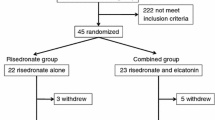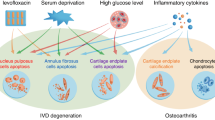Abstract
Clinical studies have suggested that postmenopausal women on estrogen replacement treatment are more likely to experience back pain and related disability compared to women who do not take estrogens. Raloxifene, a selective estrogen receptor modulator has estrogen-like effects on bone tissue, and antagonize the action of estrogens on endometrium and breast tissue. It is unknown if the treatment of osteoporosis with raloxifene has estrogen-like or opposite effects on back pain and functional capacity among postmenopausal women with osteoporosis. A total of 120 postmenopausal women with osteoporosis and chronic back pain were randomized to receive raloxifene 60 mg with 1,000 mg calcium, and 800 IU vitamin D daily or 1,000 mg calcium and 800 IU vitamin D daily. Pain intensity and pain-related disability were measured before treatment at 6 months and after 1 year. Repeated measures of ANOVA, did not reveal statistically significant differences over time, on pain intensity and disability scores, between groups studied. There was a trend in pain intensity changes during the follow-up period, but the differences between the groups were not statistically significant. It seems that treatment with raloxifene does not influence back pain and disability among postmenopausal women with osteoporosis. Raloxifene may have estrogenic agonist effects on nociceptive processing in the central nervous system.


Similar content being viewed by others
References
Ammann P, Rizzoli R (2003) Bone strength and its determinants. Osteoporos Int 14(3):13–18
Boss SM, Huster WJ, Neild JA et al. (1997) Effects of raloxifene hydrocloride on the endometrium of pstmenopausal women. Am J Obstet Gynecol 177:1458–1464
Boscainos PJ, Sapkas G, Stilianessi E et al. (2003) Greek versions of the Oswestry and Roland-Morris Disability Questionnaires. Clin Orthop 411:40–53
Brynhildsen JO, Bjors E, Skarsgard C et al. (1998) Is hormone replacement therapy a risk factor for low back pain among postmenopausal women? Spine 23:809–813
Chlebowski RT, Hendrix SL, Langer RD et al. (2003) Influence of estrogen plus progestin on breast cancer and mammography in healthy postmenopausal women: the women’s health initiative randomized trial. JAMA 289:3243–3253
Cumming SR, Eckert S, Krueger KA et al. (1999) The effect of raloxifene on risk of breast cancer in postmenopausal women. JAMA 281:2189–2197
Chudler EH, Dong WK (1955) The role of the basal ganglia in nociception and pain.Pain 60:3–38
Cyr M, Landry M, Di Paolo T (2000) Modulation by estrogen-receptor directed drug of 5-hydroxytryptamine-2A receptors in rat brain. Neuropsychopharmacology 23:69–78
Cyr M, Ghribi O, Thibault C et al. (2001) Ovarian steroids and selective estrogen receptor modulators activity on rat brain NMDA and AMPA receptors. Brain Res Rev 37:153–161
Delmas PD, Bjarnason NH, Mitlak BH et al. (1997) Effects of raloxifene on bone mineral density serum cholesterol concentrations, and uterine endometrium in postmenopausal women. N Engl J Med 337:1641–1647
Draper MW, Flowers DE, Huster WJ et al. (1997) A controlled trial of raloxifene (LY 139481) HCL : impact on bone turnover and serum lipid profile in healthy postmenopausal women. J Bone Miner Res 11:835–842
Duval P, Lenoir V, Moussaoui S et al. (1996) Substance P and neurokinin. A variations throughout the rat estrous cycle; comparison with ovariectomized and male rats: II. Trigeminal nucleus and cervical spinal cord. J Neurosci Res 45:610–616
Ettinger B, Black DM, MitlakBH et al. (1999) Reduction of vertebral fracture risk in postmenopausal women with osteoporosis treated with raloxifene: results from a 3-year randomized clinical trial. Multiple Outcomes of Raloxifene Evaluation (MORE) Investigators. JAMA 282:637–645
Ferry S, Hannaford P, Warskyj M et al. (2000) Carpal tunnel syndrome: a nested case-control study of risk factors in women. Am J Epidemiol 151:566–574
Fillingim RB (2002) Association between estrogen replacement therapy and back pain among postmenopausal women. Spine 27:332–334
Florio P, Quirici B, Casarosa E et al. (2001) Neuroendocrine effects of raloxifene hydrochloride in postmenopausal women. Gynecol Endocrinol 15:359–366
Gruber CJ, Tschugguel W, Schneeberger C et al. (2002) Production and actions of estrogens. N Engl J Med 346:340–352
Hulley S, Grady D, Bush T et al. (1998) Randomized trial of estrogen plus progestin for secondary prevention of coronary heart disease in postmenopausal women. Heart and Estrogen/progestin Replacement Study (HERS). JAMA 280:605–613
Hapidou EG, De Catanzaro D (1998) Sensitivity to cold pressor pain in dysmenorrheic and non dysmenorrheic women as a function of menstrual cycle phase. Pain 34:277–283
Heils A, Teufel A, Petri S et al. (1996) Allelic variation of human serotonin transporter gene expression. J Neurochem 66:2621–2624
LeResche L, Saunders K, Von Korff MR et al (1997) Use of exogenous hormones and risk of temporomandibular disorder pain. Pain 69:153–160
Kawata M, Yuri K, Morimoto M (1994) Steroid hormone effects on gene expression, neuronal structure, and differentiation. Horm Behav 28:477–482
Kanis JA, Johnell O, Black DM et al. (2003) Effect of raloxifene on the risk of new vertebral fracture in postmenopausal women with osteopenia or osteoporosis: a reanalysis of the Multiple Outcomes of Raloxifene Evaluation Trial. Bone 33:293–300
Landry M, Levesque D, Di Paolo T (2002) Estrogenic properties of raloxifene, but not tamoxifen, on D2 and D3 dopamine receptors in the rat forebrain.Neuroendocrinology 76:214–222
Musgrave DS, Vogt MT, Nevitt MC et al. (2001) Back problems among postmenopausal women taking estrogen replacement therapy: the study of osteoporotic fractures. Spine 26:1606–1612
McCloskey E, Spector TD, Eyres KS et al. (1993) The assessment of vertebral deformity. A method for use in population studies and clinical trials. Osteoporos Int 3:138–147
Magnusson JE, Fisher K (2000) The involvement of dopamine in nociception: the role of D(1) and D(2) receptors in the dorsolateral striatum. Brain Res 855:260–266
Ohara PT, Granato A, Moallem TM et al. (2003). Dopaminergic input to GABAergic neurons in the rostral agranular insular cortex of the rat. J Neurocytol 32:131–141
Petrenko AB, Yamakura T, Baba H et al. (2003) The role of N-methyl-Daspartate (NMDA) receptors in pain: a review. Anesth Analg 97:1108–1116
Quinones-Jenab V, Jenab S, Ogawa S et al. (1997) Estrogen regulation of mu-opioid receptor mRNA in the forebrain of female rats. Brain Res Mol 47:134–138
Shukla R, Husain M, Tandon R et al. (2003) Platelet 3H ketanserin binding in tension-type headache. Headache 43:103–108
Shumaker SA, Legault C, Rapp SR et al. (2003) Estrogen plus progestin and the incidence of dementia and mild cognitive impairment in postmenopausal women: the women’s health initiative memory study: a randomized controlled trial.JAMA 89:2651–2662
Schwarz MJ, Spath M, Muller-Bardorff H et al. (1999) Relationship of substance P, 5-hydroxyindole acetic acid and tryptophan in serum of fibromyalgia patients. Neurosci Lett 259:196–198
Sun YG, Lundeberg T, Yu LC (2003) Involvement of endogenous betaendorphin in antinociception in the arcuate nucleus of hypothalamus in rats with inflammation.Pain 104:55–63
Von Korff M, Jensen MP, Karoly P (2000) Assessing global pain severity by self-report in clinical and health services research. Spine 25:3140–3151
Wassertheil-Smoller S, Hendrix SL, Limacher M, et al. (2003) Effect of estrogen plus progestin on stroke in postmenopausal women: the women’s health initiative: a randomized trial. JAMA 289:2673–2684
Walsh BW, Kuller LH, Wild RA et al. (1998) Effects of raloxifene on serum lipids and coagulation factors in healthy postmenopausal women. JAMA 279:1445–1451
Author information
Authors and Affiliations
Corresponding author
Rights and permissions
About this article
Cite this article
Papadokostakis, G., Katonis, P., Damilakis, J. et al. Does raloxifene treatment influence back pain and disability among postmenopausal women with osteoporosis?. Eur Spine J 14, 977–981 (2005). https://doi.org/10.1007/s00586-005-0899-1
Received:
Revised:
Accepted:
Published:
Issue Date:
DOI: https://doi.org/10.1007/s00586-005-0899-1




